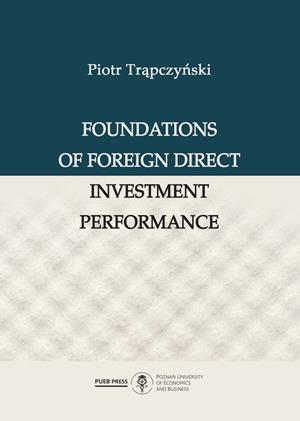
e-ISBN:
Edition: I
Publication date: 2016
First publication date: 2016
Pages: 148
Print: paperback
Electronic version: PDF
Format: B5
License : open access
last week: 2
last 3 months: 129
Piotr Trąpczyński
Foundations of Foreign Direct Investment Performance
Availability and purchase
Electronic version(CEEOL)
*Clicking the button takes you to an external open access or selling platform.
Trąpczyński, P. (2016). Foundations of Foreign Direct Investment Performance. Poznań University of Economics and Business Press.
While there have been many literature reviews devoted to firm internationalisation and foreign direct investment (FDI) as one of the forms thereof, the objective of the present volume is to reflect on the implications of existing theoretical concepts for economic consequences of undertaking foreign expansion. In fact, economic sciences deal with the allocation of scarce resources, therefore performance is an important aspect of firm operations, of both theoretical and managerial relevance. The book provides an overview of concepts explaining FDI, with a critical evaluation of their ability to account for FDI performance. Subsequently, it provides a link between FDI literature and concepts pertaining to firm competitiveness by proposing a novel conceptual approach. Finally, the findings of a quantitative analysis based on earlier studies of FDI performance are presented in order to critically reflect on factors determining the outcomes of foreign expansion. The book presents the conceptual part of the doctoral dissertation written within a research project financed by the National Science Centre (grant DEC-2012/07/N/HS4/00283).
1. Introduction and overview
1.1. Topic relevance
1.2. Objectives and structure
1.3. Definitions and assumptions
1.3.1. Foreign direct investment (FDI)
1.3.2. FDI performance
1.3.3. Basic assumptions
2. Theoretical foundations of FDI as an internationalisation mode
2.1. FDI as a part of firm internationalisation
2.1.1. Internationalisation of the firm
2.1.2. Multinational enterprises
2.2. Towards a typology of theoretical concepts explaining FDI
2.3. Process perspectives on FDI
2.3.1. Content-oriented process perspectives
2.3.1.1. Uppsala model
2.3.1.2. Finnish model
2.3.1.3. German approaches
2.3.1.4. Product cycle theory
2.3.1.5. Other process determinants
2.3.2. Activity-oriented process perspectives
2.4. Content perspectives on FDI
2.4.1. Monopolistic advantage theory
2.4.2. Internalisation theory
2.4.2.1. The notion of transaction costs
2.4.2.2. Fundamental arguments of internalisation theory
2.4.2.3. Internalisation theory extensions
2.4.2.4. Explanatory capacity of the theory
2.4.3. Location theories
2.4.4. The eclectic (OLI) paradigm as an integrative framework
2.4.4.1. Rationale for an integrative framework
2.4.4.2. The OLI advantages
2.4.4.3. FDI motives
2.4.4.4. Criticisms of the eclectic paradigm
2.5. Institution-based view and international business theory
2.5.1. Notion and classifications of institutions
2.5.2. Relevance of institutions for MNE operations
2.5.3. Institution-based view and the OLI paradigm
2.6. Summary and critical evaluation
3. FDI performance – conceptual and empirical perspectives
3.1. MNE competitiveness
3.1.1. Definitions and essence of firm competitiveness
3.1.2. Determinants of firm competitiveness
3.1.3. Selected concepts of firm competitiveness
3.1.3.1. The concept of Gorynia
3.1.3.2. The concept of Stankiewicz
3.1.3.3. The concept of Buckley, Pass and Prescott
3.1.3.4. Interim summary
3.1.4. Constituents of MNE competitiveness
3.1.4.1. Competitive potential of the MNE
3.1.4.2. Competitive strategy of the MNE
3.1.4.3. Competitive position of the MNE
3.2. FDI performance as a competitiveness dimension of the MNE
3.2.1. The notion of performance
3.2.2. MNE performance measurement levels
3.2.3. Issues related to FDI performance measurement
3.3. Critical review of studies on FDI performance determinants
3.3.1. Review method
3.3.2. Findings
3.3.2.1. FDI modes and FDI performance
3.3.2.2. Host-country determinants of FDI performance
3.3.2.3. Resource determinants of FDI performance
3.3.2.4. MNE strategy and FDI performance
3.3.2.5. Quantitative assessment of performance determinants
3.3.3. Summary and research gaps
Conclusions and implications
References
List of tables
List of figures


